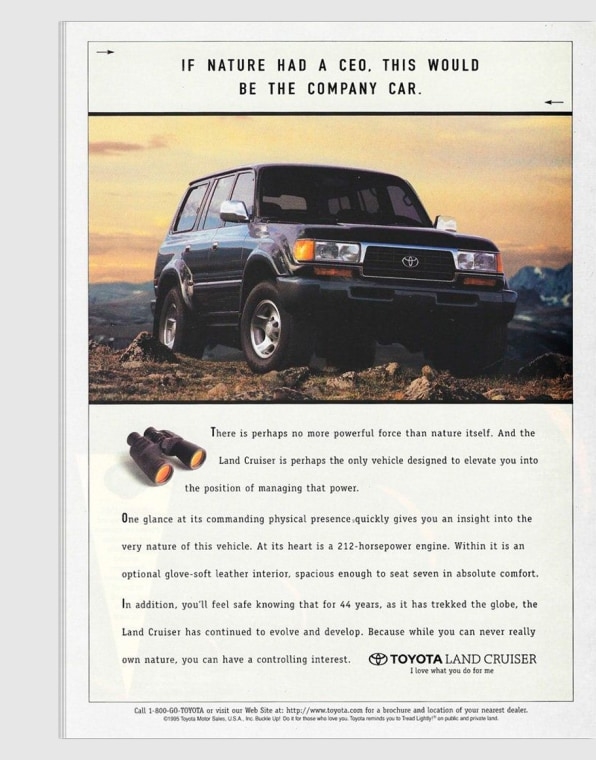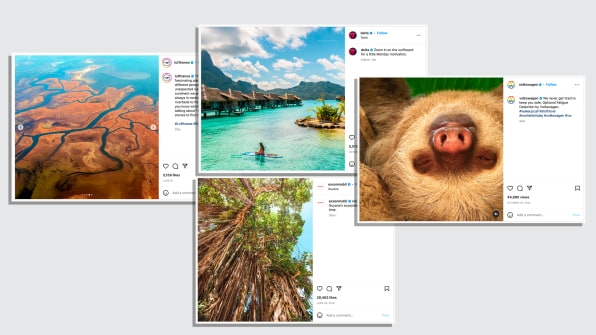‘Nature-rinsing’ is the perfect term for our age of climate anxiety
By John Kazior
This past summer, Mercedes-Benz rolled out an ad called “Nature or Nothing.” In it, the luxury car brand depicted a random montage of nature-related imagery—the veins of a leaf, a gooey honeycomb cell, the folds between rose petals—that served as the lines for the company’s three-spoke logo.
The controversial campaign for the Mercedes EQS electric vehicle line was devised by the Mexico office of global ad agency Leo Burnett. Though the ad made no explicit mention of what these cars had to do with the nature-related images used in the campaign, the connection was implicit: This low-occupancy vehicle was on the side of nature, despite much evidence to the contrary.

After its launch, the ad garnered the kind of attention brands dream of. Unfortunately for Mercedes, that attention came in the form of ridicule and outrage. (Mercedes later distanced itself from the ad, claiming it was not approved for global rollout). Across the internet, claims of greenwashing were being thrown around. And yet it’s clear that the campaign participated in a deeper sort of visual deceit. It wasn’t just greenwashing—it was nature-rinsing.
The term was coined earlier this year in a study from the Algorithmic Transparency Institute and Geoffrey Supran, a research associate in the history of science department at Harvard University. It describes the systematic use of nature-evoking imagery to enhance the “greenness” of a brand image. The study examined nearly 34,000 social media posts from 22 different fossil fuel companies and found that 97% of posts from airlines, 64% of posts from automakers, and 56% of posts from oil companies deploy nature-evoking imagery.
Nature-rinsing isn’t a new approach, but it feels like a pitch-perfect term to describe our current moment in ecological gaslighting. “It is a classic trick. I think marketers have relied on these heuristic cues forever,” says Cristel Russell, a marketing professor at Pepperdine’s Graziadio Business School who coauthored a 2015 report on the strategy, then known as “executional greenwashing.”

Research on the subject goes back at least as far as the early 1990s, but the automobile and travel industry have used nature-related imagery as a marketing strategy for more than a century. Fast-forward to today, and it’s even more egregious.
The Mercedes “Nature or Nothing” campaign is a particularly offensive example of nature-rinsing, yet it’s just a stand-in for countless posts and promotions from other fossil fuel giants, like Lufthansa’s bird’s-eye photography of untouched landscapes, Volkswagen’s sleepy two-toed sloth, BP’s wind farms at sunset, BMW’s favorite season for driving, Delta’s clear-blue Tahitian lagoon, Exxon’s trees in Guyana, or Toyota’s Land Cruiser advertisement. All of these images are easily found and exchangeable for countless other advertisements from brands showing their alliance with nature in the vaguest possible sense.

The arrival of a term like nature-rinsing is timely for all the worst reasons. Supran’s findings tell us not just about the endless efforts of fossil-fuel-dependent companies to deceive but also about the heightened level of climate fear many people are currently feeling. Nature-rinsing “works” best when consumers are feeling worried about the climate or ecosystem.
“Present issues such as global warming may indeed enhance consumer awareness and acceptance of the need to consume in an environmentally cognizant manner compared to other times,” says Les Carlson, a professor of marketing at the University of Nebraska who has researched green marketing since the early 1990s. “?When consumers are concerned about other more pressing issues such as loss of jobs, decreasing incomes, health worries, etc., environmental product attributes may be of less interest.”
It’s no coincidence that Supran’s damning report coincided with an onslaught of news about megadroughts, record-breaking heat waves, and wildfires. The strategy deftly serves brands and corporations that are coming under increasing scrutiny for their role in the crisis. “I would hypothesize that the prominence of nature-rinsing by fossil fuel interests has increased in lockstep with public and political awareness of the climate crisis, but that requires further investigation,” Supran says.
The visual suggestion of nature-rinsing is not only effective for these companies—it is also easy to deploy and challenging to regulate. The use of nature, whether it is for extraction and exploitation or for picturesque ad content, comes with little accountability.
“As of now, lawsuits mainly focus on reprimanding false and misleading claims—not visual representations of nature,” said Julie Mallat of Creatives for Climate and of the Climate Propagandist, an Instagram account drawing attention to common greenwashing marketing strategies.
Regulatory agencies, mostly in Europe, have used research around greenwashing to restrict the spread of deceptive advertising. But only in France, the U.K., and Australia has regulation been introduced that specifically targets the use of the ambiguous visual messaging that defines nature-rinsing.
The global use of these images on digital media platforms such as YouTube, Instagram, TikTok, Facebook, and Twitter only adds to the complications. “We need legislation, not just regulation,” says Robbie Gillett of Adfree Cities, a U.K. organization campaigning against the influence of corporate advertising. The group recently won a case against HSBC, forcing the bank to remove a misleading advertisement that capitalized on the climate crisis and COP27 (the U.N.’s climate change summit) even as it continues to significantly finance businesses expanding carbon emissions.
“Given the shortening window of time available for reducing greenhouse gas emissions, we cannot afford decades of piecemeal regulatory reforms against high-carbon ads—for example by banning the use of green imagery or green-sounding language,” Gillett says. “The practice of greenwashing is too widespread and the regulators are under-resourced and overwhelmed.”
Fortunately, federal investigation into greenwashing is growing in the U.S. This month, a year-long investigation from the House Oversight Committee found that Big Oil has been engaged in a long-running greenwashing campaign. And as more brands cash in on consumer concerns about climate, more class-action lawsuits are being brought against companies. At the same time, the Federal Trade Commission is working to update its now long-outdated “green guides,” which provide non-legally binding rules to prevent greenwashing claims from brands (though the FTC doesn’t even monitor certain markets like airlines.)
The subtle and ubiquitous quality of nature-rinsing certainly adds to the already strong case for legislation around fossil fuel company advertising and marketing material in general—and it raises some fundamental questions about what may even be considered reasonable in advertising for such companies. After all, if something as elemental as an image of a tree is enough to manipulate people’s impression of a brand and product, then what image or design could possibly be considered reasonable? And what leniency should be offered to industries that have a vested interest in sewing climate catastrophe?
Nature-rinsing may not be a new strategy, but as a word it could prove invaluable. Will it help us to see through the false assurances of glistening rivers at dawn, ocean expanses, cute furry animals, and other ads for fossil fuel corporations that have been touched up with lush green foliage?
“They say that the first step to solving a problem is recognizing there is one,” Supran says. “Giving the problem a name we can all remember is surely a good place to start.”
(22)



